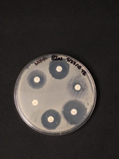EVANSTON, Ill., USA (December 11, 2018) — Most people have heard about antibiotic-resistant germs. But how about antibiotic-resistant dust? A new Northwestern University study has found that an antimicrobial chemical called triclosan is abundant in dust — and linked to changes in its genetic makeup. The result is dust with organisms that could cause an antibiotic-resistant infection.
HAUPTMENÜ
AWARDS
Forschergeist gefragt: 14. Novartis Oppenheim-Förderpreis für MS-Forschung ausgelobt
FernstudiumCheck Award: Deutschlands beliebteste Fernhochschule bleibt die SRH Fernhochschule
Vergabe der Wissenschaftspreise der Deutschen Hochdruckliga und der Deutschen Hypertoniestiftung
Den Patientenwillen auf der Intensivstation im Blick: Dr. Anna-Henrikje Seidlein…
Wissenschaft mit Auszeichnung: Herausragende Nachwuchsforscher auf der Jahrestagung der Deutschen…
VERANSTALTUNGEN
Wichtigster Kongress für Lungen- und Beatmungsmedizin ist erfolgreich gestartet
Virtuelle DGHO-Frühjahrstagungsreihe am 22.03. / 29.03. / 26.04.2023: Herausforderungen in…
Pneumologie-Kongress vom 29. März bis 1. April im Congress Center…
Die Hot Topics der Hirnforschung auf dem DGKN-Kongress für Klinische…
Deutscher Schmerz- und Palliativtag 2023 startet am 14.3.
DOC-CHECK LOGIN
Antimicrobial chemical tied to antibiotic resistance genes in dust
Stop sterilizing your dust
„There is this conventional wisdom that says everything that’s in dust is dead, but that’s not actually the case. There are things living in there,“ said Northwestern’s Erica Hartmann, who led the study. „Dust is the final resting place of everything that’s been circulating in the air, so it can give us information about air quality.“
The study was published today (Dec. 11) in the journal mSystems. Hartmann is an assistant professor of environmental engineering in Northwestern’s McCormick School of Engineering. This work was done in partnership with the Biology and the Build Environmental Center at the University of Oregon.
Hartmann’s study compared dust samples collected from 42 athletic facilities in the Pacific Northwest region. (Hartmann selected athletics facilities because people tend to make intimate contact with the floor, mats and equipment and use antimicrobial wipes to cleanse these areas before and after exercising.) Her team looked at the bacteria present in dust, specifically examining the bacteria’s genes.
In dust with higher concentrations of triclosan, the researchers found higher abundances of genetic markers indicating antibiotic resistance. „Those genes do not code for resistance to triclosan,“ Hartmann clarified. „They code for resistance to medically relevant antibiotic drugs.“
Up until 2017, manufacturers commonly added triclosan to antibacterial hand soaps and cleaning solutions. The Federal Drug Administration (FDA) banned triclosan in 2016, after discovering several dangerous side effects, including its potential to interfere with the human endocrine system. But even though it is no longer contained in hand soaps and the antibacterial wipes that people often use at the gym, triclosan is still present in toothpaste and many consumer products that are not labeled.
„There are many products with triclosan that are not labeled because they are within the purview of the EPA instead of the FDA,“ Hartmann said. „These things might include antimicrobial gym equipment, such as yoga mats and textiles.“
Antibiotic resistance is an enormous threat to public health. According to the Centers for Disease Control and Prevention, nearly 25,000 people in the United States die each year from antibiotic-resistant infections. Even though triclosan has been banned, soaps and cleansers still contain other antimicrobial chemicals, including benzalkonium chloride, which Hartmann’s team is now studying to see if it has a similar effect on dust.
Hartmann believes we could ease the problem of antibiotic-resistant bugs by letting go of antimicrobial products.
„The vast majority of microbes around us aren’t bad and may even be good,“ she said. „Wipe down gym equipment with a towel. Wash your hands with plain soap and water. There is absolutely no reason to use antibacterial cleansers and hand soaps.“
—
„Antimicrobial chemicals associate with microbial function and antibiotic resistance indoors“ was partially supported by the Alfred P. Sloan Foundation.
IMAGE: This photo shows a disc diffusion test, where each disc contains a different antibiotic. The discs covered in growing bacteria contain bacteria that are resistant to antibiotics. Credit: Taylor Brown/Northwestern University
Northwestern University, 11.12.2018 (tB)



